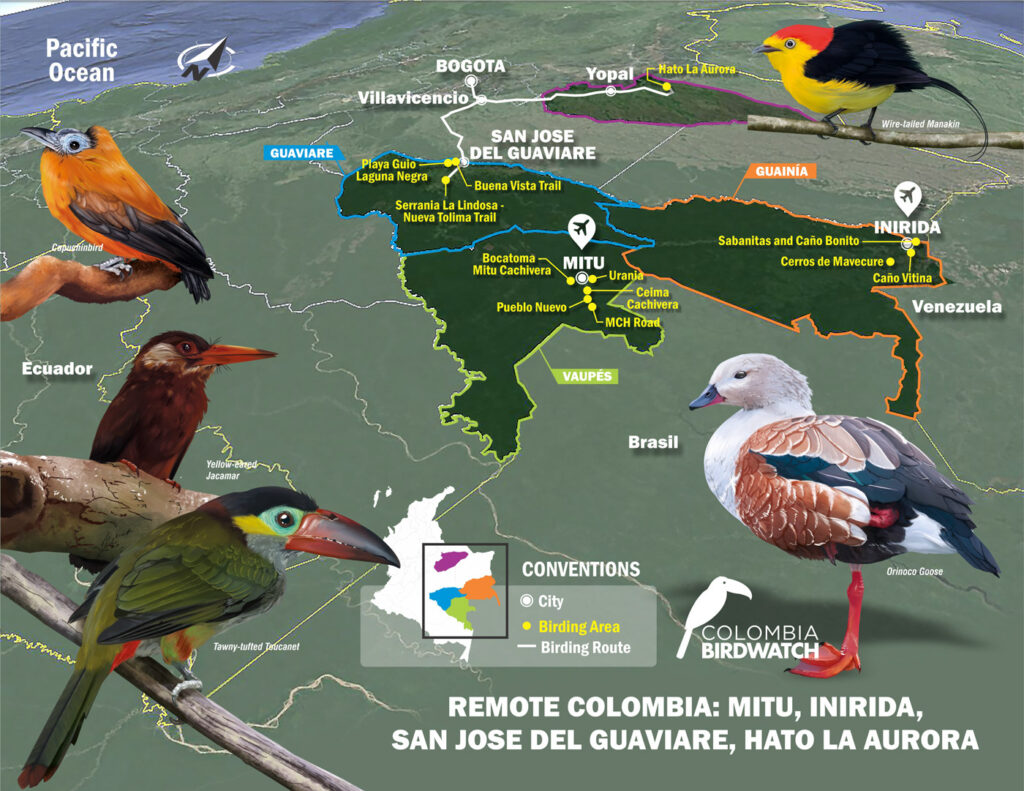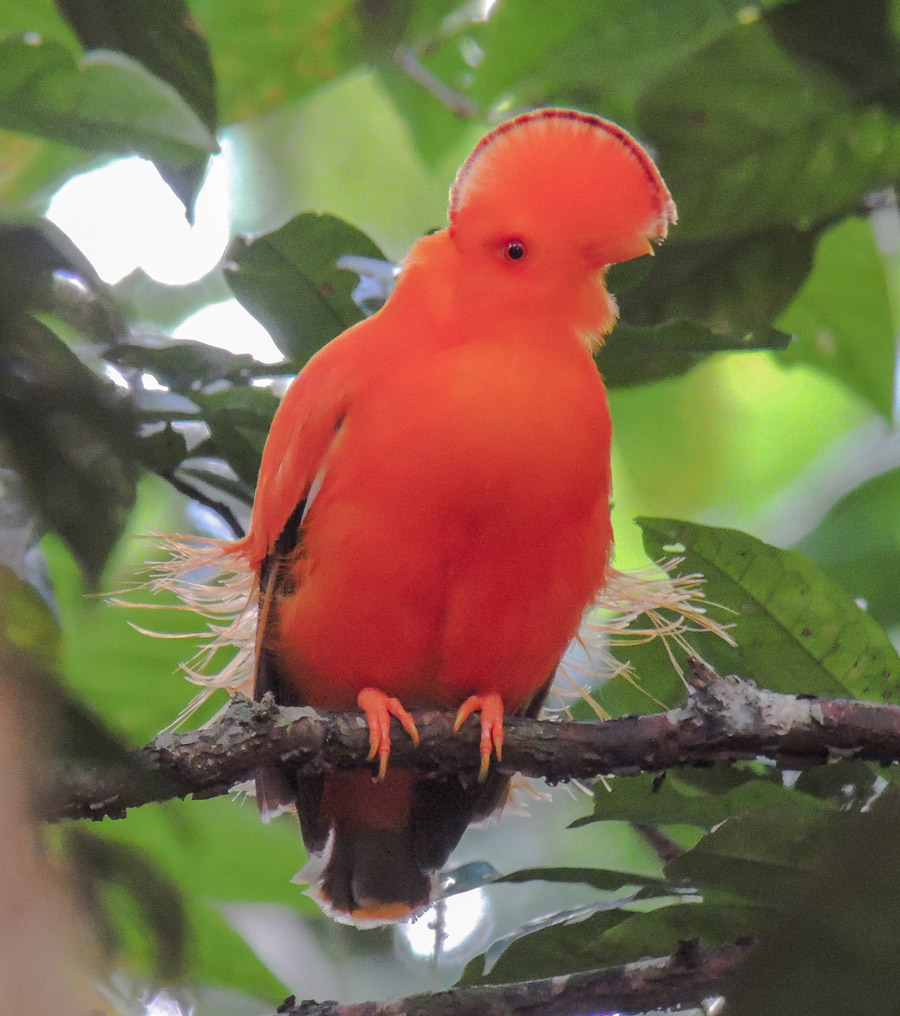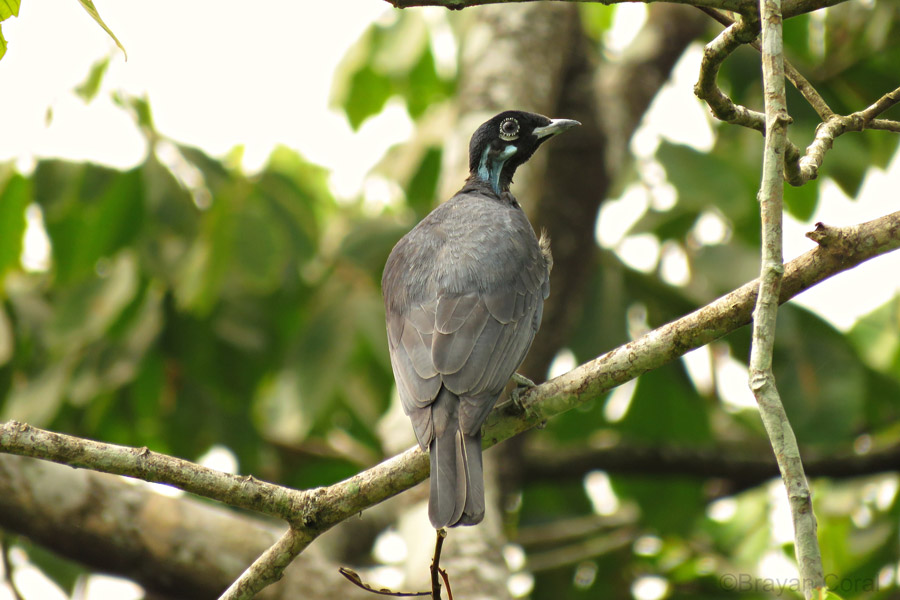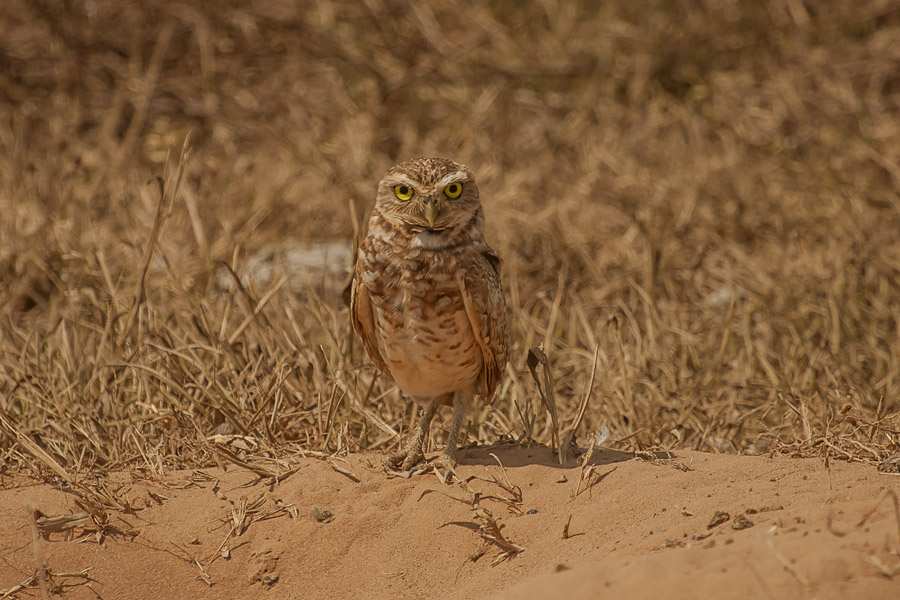This route highlights various birding sites in remote destinations in the Amazon and Orinoco regions of Colombia. As remote as these areas are, getting there is actually not that hard as Colombia counts with good road infrastructure and an excellent network of internal flights. Considering these destinations are spread out geographically, the best months to visit and accessibility will vary.
AREAS IN THIS ROUTE
Mitu is one of the most remote birding destinations in Colombia, containing unique vegetation, topography and avifauna than the rest of the Colombian Amazon. A mosaic of habitats can be found in close vicinity of the town, including the unique, nutrient-poor white-sand forest belts, cerros (isolated tabletop mountains that stand above the surrounding forest), Terra Firme (upland) tropical forests, gallery forests and seasonally flooded Varzea Forests. Many of the trails are on property owned by the local tribe, so we work closely with local guides and the community to ensure access to the best birding areas.
Best Months to Visit:
Late October to late March
Pueblo Nuevo is a two hour drive from Mitu.
Targets: Topaz, Lafresnaye’s Piculet, Magpie Tanager, Amazonian Trogon, Great Jacamar, Musician Wren, Chestnut-crested Antbird, Thrush-like Antpitta, Golden-headed Manakin. Rufous-tailed Xenops, Black Bushbird, Scarlet-shouldered Parrotlet, Orange-cheeked Parrot.
Ceima Cachivera is a two hour drive from Mitu.
Targets: Guianan Cock-of-the-rock, Lemon-throated Barbet, White-crowned Manakin, Black-headed Parrot, White-bellied Dacnis, Mouse-colored Antshrike, Black-bellied Thornbill, Rufous-headed Antthrush, Turquoise Tanager, Black-fronted Nunbird, Rufous-browed Peppershrike, Blue-crowned Manakin, Coraya Wren, Bar-bellied Woodcreeper, Gray-bellied Antbird, Imeri Warbling-Antbird, Blakish-gray Antshrike, Brown-headed Greenlet, Purple-breasted Cotinga, Black Manakin.
Bocatoma – Mitu Cachivera is a ten minute drive from Mitu.
Targets: Point-tailed Palmcreeper, Pompadour Cotinga, Many-banded Aracari, Spangled Cotinga, Chestnut-eared Aracari, Yellow-tufted Woodpecker, Amazonian Umbrellabird, Pearly Antshrike, Paradise Tanager, Paradise Jacamar, Black-capped Donacobius, Dwarf-tyrant Manakin, Screaming Piha, Citron-bellied Attilla, Opal-rumped Tanager, Green-and-gold Tanager, Yellow-bellied Tanager, Yellow-browed Antbird, Scaled Pigeon, Swallow-winged Puffbird, Yellow-green Grosbeak.
Urania is a ten minute drive from Mitu.
Targets: White-browed Purple-tuft, Red-fan Parrot, Bronzy Jacamar, Cherrie’s Antwren and Green-backed Trogon, Brown-banded Puffbird, Pavonine Quetzal, Black-chinned Antbird, Swainson’s Flycatcher, Azure-naped Jay.
San Jose del Guaviare is the capital of the Guaviare state and can be easily accessed by air from Bogota or by road from Villavicencio. The area is unique and outstanding for birding as it is located where the Llanos ecosystem meets the Amazon rainforest, making it a true mecca for diversity.
Playa Guio provides a seasonally flooded varzea forest which is influenced by the nearby Guaviare River.
Targets: Bare-necked Fruitcrow, White-eared Jacamar, Spot-crowned Barbet, Cream-colored Woodpecker. Black Caracara, Magpie Tanager, Long-billed Woodcreeper, Purple-throated Fruitcrow, Many-banded Aracari, Brown Nunlet, Pink-thorated Beccard, White-shouldered Antbird and Citron-bellied Attila, Hoatzin, American Pygmy Kingfisher, Horned Screamer, Black-capped Donacobius.
Buenavista is located within the municipality of San Jose del Guaviare, and 345 species have been recorded in this complex of wetlands, lagoons, pastures, and riparian forests along the Guaviare River.
Targets: Agami Heron, Sungrebe, Black-fronted Nunbird, Yellow-bellied Dacnis, Amazonian Trogon, Screaming Piha, Velvet-fronted Grackle, Swallow-winged Puffbird, Fork-tailed Palm Swift, Little Cuckoo, Blue Dacnis, Great Potoo.
Nueva Tolima Trail:
Just one hour form San Jose del Guaviare, the trail skirts through ancient rock formations which are remnants of the Guianan Shield, the oldest known formation on the planet. Large murals left by pre-columbian groups are a testament to the daily life, culture and ideologies of the people who inhabited the land in the past.
Targets: Guainan Cok-of-the-rock, Paradise Tanager,The uncommon Wing-barred Piprites tops th elist for targets, but other species of interest include Cliff Flycatcher, Masked Tanager, Golden-bellied Euphonia, Opal-rumped Tanager, Chestnut-eared Aracari, and Yellow-billed Nunbird.
Best Months to Visit:
Best times to visit: November to Late March
Bordering with Venezuela, the municipality of Inirida in the Guainia state is one of Colombia’s best kept secrets. Inirida arguably has the best white sand forests of the Amazon region in Colombia, and is easily accessed by air from Bogota. Once there, getting to the birding sites of Caño Vitina, Sabanitas and Caño Bonito by land is easy. Cerros de Mavecure, a collection of three impressive monoliths along the Guainia River, is accessed by boat and is a sight to behold.
Best Months to Visit:
Best times to visit: Late November to March
Targets:
Capuchinbird, Golden-spangled Piculet, Orinoco Piculet, Orinoco Softail, Green-tailed Goldenthroat, Azure-naped Jay, Yellow-crowned Manakin, Ringed woodpecker, Dot-backed Antbird, Yapacana Antbird, Black-bellied cuckoo, Spotted Puffbird, Citron-bellied Atilla, Brown-headed Greenlet, White-naped Seedeater.
Hato la Aurora, in the Casanare Department, is a 16,000 hectare (40,000 acre) private cattle ranch whose owners aim to strike a balance between preserving the unique llanos ecosytem and maintaining the lifestyle and traditions of the llanero people. Daily flights from Bogota land in the city of Yopal, from which a six hour drive is required to reach the Juan Solito Lodge (birding along the way).
Best Months to Visit:
December to March
Targets:
White-bearded Flycatcher (E), Pale-headed Jacamar (E), Horned Screamer, Scarlet Ibis, Jabiru, Orinoco Goose, Double-striped Thick-knee, Maguari Stork, Pinnated Bittern, Sharp-tailed Ibis, Crane Hawk, Masked Cardinal, Oriole Blackbird, Violeaceous Jay, Rufous Motmot, Great Potoo, Green-and-rufous Kingfisher, Scaled Piculet, Burrowing Owl, Nacunda Nighthawk, Yellow-browed Sparrow, Yellowish Pipit, Buff-necked Ibis, Wedge-tailed Grassfinch, Black-capped Donacobius, Rusty-backed Spinetail, Spectacled Thrush, Small-billed Elaenia, Sunbittern.
CONTACT US
SEND US A MESSAGE
CONTACT INFORMATION
For more information, questions, availability or to register for a Colombia Birdwatch tour, please contact Christopher Calonje at:





